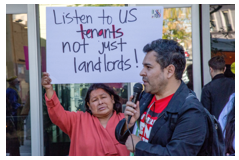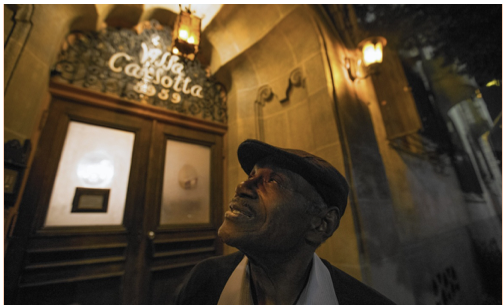CommentsVOICES--Los Angeles is in the throes of an unprecedented housing affordability crisis, with homelessness at historic highs. So why does our planning department see fit to allow developers to buy up affordable, rent-stabilized buildings and convert them to luxury, million-dollar condominiums?
If you’re an average person living in Los Angeles, you’ve probably read one of the hundreds, if not thousands, of articles about the housing crisis, and all the ways that city officials propose to address it.
However, behind the scenes (and beyond any scrutiny), the city’s Department of City Planning regularly processes land use applications that seek to convert rent-stabilized (RSO) apartments to more profitable real estate ventures, such as luxury condos and hotels. Its purpose is simply an extraction of higher profits for the speculators who buy up existing buildings- not for the value of what they are in their current use- but for the value they can derive as something else.
These types of “redevelopment” projects displace long-term tenants from below-market rental units, drive up rent prices, and spur gentrification and homelessness. In fact, the latest figures indicate that the major contributing factor to recent rises in homelessness is unaffordable rent. The nearly 620,000 RSO units throughout the city, most of which are stabilized at rents far below market, represents the bulk of our affordable housing stock. We need to do everything possible to hold onto each and every one of them.
It was a proposed hotel conversion that caused me to be evicted from my home at the 50-unit historic Villa Carlotta in Hollywood and has compelled me since to examine more closely the way the city processes these projects. This is a time when the city should be doing everything possible to hold onto its desperately-needed and diminishing RSO stock.
So why is city planning using its discretion to approve the wholesale conversions of these buildings? And why is it incumbent upon an activist citizenry to call out all the errors it makes in the process? A cynic might point to the additional income the city receives from a higher tax basis as a result of these projects. But the short-sighted thinking is simply digging a hole that we will never fill. And stuck in this hole are renters of the city of Los Angeles.
Alongside the affected tenants who are currently being Ellis Act evicted, I am an appellant to the decision to allow the conversion of a lovely 1920s spanish revival fourplex at 121 N. Sycamore, on the western edge of the Greater Wilshire neighborhood to luxury condominiums. The 2 bedroom/1 bath apartments are currently rent-stabilized at more than $1000 below the area market rent but are projected at sales prices of between $1,000,000-1,500,000 once they are converted.
The city’s condominium conversion ordinance states that one of its intents is, “to protect the existing rental housing stock by reducing conversions” and prescribes two conditions under which a project should be denied:
- that the vacancy rate is below 5% and
- the project will have a significant cumulative effect on the rental market in the community plan area.
This summer, on behalf of the LA Tenants Union, I led an appeal of a nearby condo conversion exposed the planning department’s use of flawed vacancy data from the Department of Water and Power to approve conversions on the erroneous basis that vacancy was above 5%.
See articles:
LA struggles to get vacancy data in face of housing crisis
L.A. overrules tenant activists, allows Beverly Grove apartments to become condos
Planning has since changed its methodology in the calculation of vacancy rates but continues to approve projects under the premise that these projects will not have a significant cumulative effect on the rental market and suggesting that it need only consider successive conversions, not other project types. This despite the fact that code states that it should consider “any other factor pertinent to the determination”.
 I should like to think that our homelessness crisis is pertinent; or the more than 50% of tenants in this city who are rent-burdened is pertinent; or the increasing number of stories of tenants in low-income communities throughout the city who are being evicted to make way for higher paying tenants is pertinent. But City Planning doesn’t seem to agree.
I should like to think that our homelessness crisis is pertinent; or the more than 50% of tenants in this city who are rent-burdened is pertinent; or the increasing number of stories of tenants in low-income communities throughout the city who are being evicted to make way for higher paying tenants is pertinent. But City Planning doesn’t seem to agree.
The residents of Sycamore reached out to me in the hopes that I could help them navigate the tedious and complex process of a land use appeal which goes before a citizen-appointed commission in what should be- but is not- a fair hearing. The mayoral-appointed Commissioners usually defer to the advice of the city attorney and planning staff present- the very same planners whose decision an appellant is challenging. Not surprisingly, their inclination is to defend their initial decision.
This appeal is a case-study in how city planning has been contributing to the rise of Ellis Act evictions and to the loss of more than 22,000 rent-stabilized units since 2001. Even worse is the carelessness with which the department doles out these approvals, as applications are processed without all the requisite paperwork and information as required by the city’s zoning code.
At an initial 2 ½ hour hearing on this appeal, which occurred in October, more than 20 local residents and a rep from Councilmember Koretz’s office came out to voice strong opposition. Amongst the arguments was that important items were missing from the file when City Planning haphazardly processed the application. For example: a list of available and comparative rentals in the area and a certified parking plan. Moved by public testimony, the Commission grilled staff on a number of the points raised before opting to continue the hearing to a later date and asking the planning department to return with additional information. Even though planning staff initially denied that the application was ever incomplete, missing documents suddenly appeared in the case file as the applicant was asked to submit the paperwork in an effort to complete the file and justify the approval.
This is the fifth proposed condominium conversion resulting in a cumulative loss of 49 RSO units within only 1000 feet of the project site. That seems pretty cumulatively significant but the planning department is considering these cases as if they were ‘just four units’ being converted in a vacuum .
At the October appeal hearing, when questioned by the Commissioners about how city planning draws the conclusion whether a project meets the threshold, planning staff present stated, “There’s not a concrete threshold for significant cumulative impact. It’s really judgment.”
Question is, how many more people have to end up on the street before the Planning Department begins to exercise better judgment? At a time of unprecedented rent burden and homelessness, the loss of one unit has a quantifiable cumulative impact.
The five occupants of these units are not just in the fight for their homes, they are in the fight for their community. With comparable units in their neighborhood averaging far above what they are paying now in rent, these tenants will end up moving to another neighborhood, further east or south, into lower-rent areas, fueling the process of gentrification and joining the throngs of tenants throughout LA who are being displaced just so investors can make a buck.
“Trading 4 RSO units for 4 million-dollar condos doesn’t make any sense to me or anyone else” LA Tenants Union member Andrew McNeely concluded in his one-minute testimony at the first hearing. I agree. We need to challenge every planning decision that strips away affordable units to convert or build luxury replacements. We need to tell our stories about rent burden and displacement. We need to show up, stand up and say enough is enough.
Please come to City Hall on Tuesday, December 12, 2017 at 4:30pm in Room 1070 and say NO! to any more displacement and loss of affordable units for luxury housing.
(Sylvie Shain is a member of the LA Tenants Union and former District 13 City Council Candidate.)
-cw






